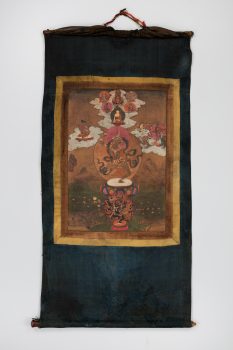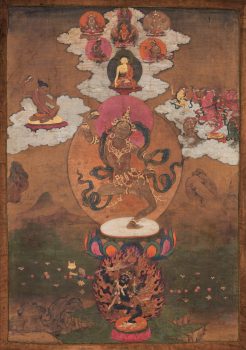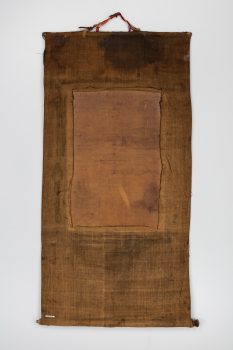Kham Province, Eastern Tibet
19th century



Kham Province, Eastern Tibet
19th century



Machik Labrdon, a woman famous for her mastery of the tantric practice known as “cutting through ego” (chod), is shown adorned in bone ornaments, dancing to the sounds of her drum (damaru) and the bell she holds.To her right are dakinis, goddesses who walk the skies, dancing with her. To her left, a tantric master, possibly Machik’s teacher, is blowing into a leg bone trumpet. A personification of the Perfection of Wisdom, the deity Prajnaparamita is above her among the buddhas, symbolizing that the realization of the empty nature of reality is what frees one from the attachment to self, the root cause of all suffering. Chod practitioners intentionally visualize in their mind’s eye their own bodies as offerings to the gods and spirits.
In Buddhism gender is considered more fluid compared to some other religions. Certain traditions emphasize the importance of all genders in achieving enlightenment. The feminine is considered an embodiment of wisdom and the masculine is an embodiment of method.
The passing down of authentic Buddhist teachings from a teacher to a disciple or student, often in the form of a text in a ritualistic context.
The transmission of teachings from one generation to the next, from teacher to student, traced all the way back to the Buddha without interruption. A complete lineage is essential in Tantric Buddhist practices as it makes the blessings of the teaching more powerful.
Himalayan art includes portraits of legendary and historical humans, including accomplished religious teachers (lamas), the Buddha’s original disciples (arhats), and spiritually accomplished tantric masters (mahasiddhas).
Today, Tibetans primarily inhabit the Tibetan Plateau, situated between the Himalayan mountain range and the Indian subcontinent to the west, Chinese cultural regions to the east, and Mongolian cultural regions to the northeast. During the 7th to 9th century, Tibetan rulers expanded their empire across Central Asia, and established Buddhism as the state religion.
Get the latest news and stories from the Rubin, plus occasional information on how to support our work.